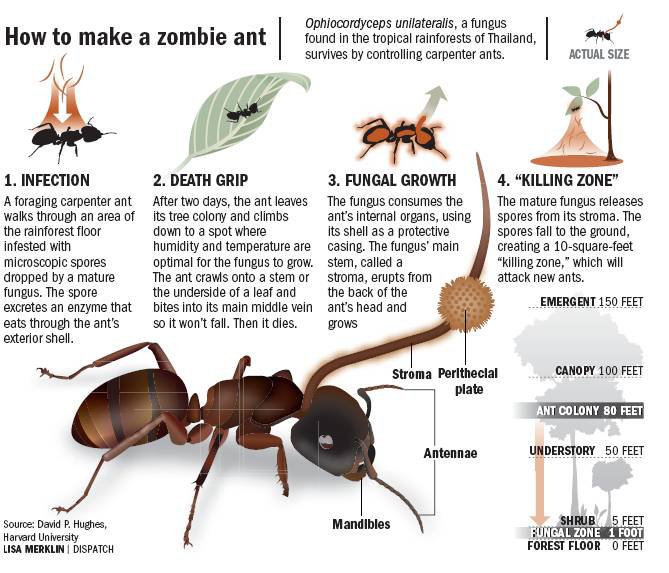The Zombie Ant: Parasitic Fungi and Behavior Manipulation
Biology 342 Fall 2014
Kristin Hirata
Ontogeny
Throughout its lifetime, the fungus develops in response to environmental conditions.
To be precise, on the "Four Questions" page of this website, ontogeny is described as the interaction between an organism's genes and its environment. In this case, however, the situation is a bit more complicated because it involves two organisms (the fungus and its host) that influence each other's behavior and environment. This section will therefore provide a detailed description on the progressive interaction between the two organisms.
The ant begins to convulse after infection, causing it to fall close to the forest floor and initiate a "death grip" on a nearby leaf.
Once infected, the ant walks away from its colony that is located high in the forest canopy. While walking, the ant experiences irregular whole body convulsions, which often causes the ant to fall from the higher levels in the rainforest to lower levels. Eventually the infected ant lands on the ground, after which it climbs a small sapling or plant. In comparison, an uninfected ant rarely leaves the high forest canopy, only descending when a break in the canopy necessitates it and almost never falling from vegetation. At noon, infected ants bite into the major vein of a nearby leaf, suggesting that the cue is somehow correlated to the sun, temperature or humidity. It is also likely that the biting behavior on the vein is stimulated by the raised section of the vein in comparison to the rest of the leaf. Subsequently, the ant dies, and the muscles of the infected ant atrophy rapidly, triggering a “death grip” on the leaf that imbeds the mandibles deep into the plant tissue (Hughes et al., 2011).
Prior to the death of its host, Ophiocordyceps unilateralis manipulates its host's behavior in response to the temperature and humidity of the surrounding environment.
When the temperature and humidity are not conducive for proliferation, Ophiocordyceps unilateralis will direct its host to a more hospitable environment that is closer to the forest floor. After the ant reaches a suitable location, the fungus manipulates its host so that the ant no longer convulses and staggers, thereby stopping further descent. To make certain that it remains in the new environment, the ant then anchors itself by biting into a nearby leaf vein. Thus, O. unilateralis alters the behavior of its host to ensure that the process completes in a location that is conducive to the fungi's survival and propagation.
Following the death of its host, the fungus proceeds to develop and reproduce in the favorable environment.
After the death of the ant, sparse hyphae grow from the cuticle while other hyphae secure the ant to the leaf. Stroma then begins to grow from the ant head, and the hyphae turn brown (characteristic of Ophiocordyceps unilateralis). One to two weeks after the ant's death, the fungus transitions to sexual reproduction. A unilateral perithecial plate develops on the stroma, which then releases sexual spores. Both the stroma and the unilateral perithecial plate can be seen on the ant diagram below. The spores then fall to the forest floor, dispersed over a short distance. Because the host ant rarely ventures to the forest floor, the fungus engages in spore production over an extended period of time in order to ensure that it infects the occasional passing C. leonardi ant (Andersen et al., 2009), a phenomenon known as iteroparous reproduction (see "Adaptive Value" for further details).

Figure 3. An overview of the life cycle of Ophiocordyceps unilateralis. The stroma and perithecial plate are visible. Source: David Hughes, Harvard University